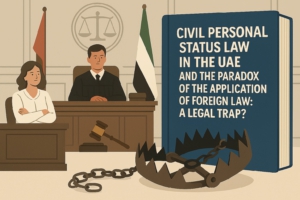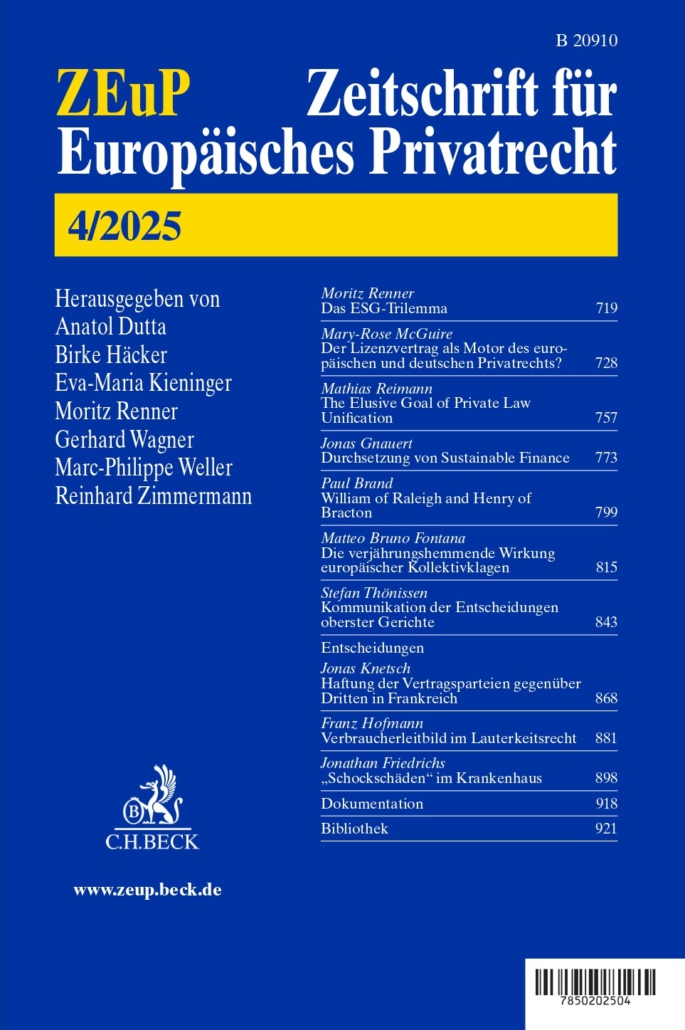Views
Civil Personal Status Law in the UAE and the Paradox of the Application of Foreign Law: A Legal Trap?

I. Introduction (*)
(*) For the sake of simplicity, reference will be made only to Federal Decree-Law No. 41/2022 of 2 October 2022 on Civil Personal Status. The Emirate of Abu Dhabi has enacted a separate law that addresses similar matters at the local level. For a comparison of the various applicable legal frameworks in family law in the UAE, see Béligh Elbalti, “The Personal Status Regimes in the UAE — What’s New and What Are the Implications for Private International Law? A Brief Critical Appraisal”.
There is no doubt that the introduction of the Civil Personal Status Law (CPSL) in the United Arab Emirates marks a significant turning point in the region’s legal landscape, particularly in areas traditionally governed by religious norms. The CPSL refers to the special law adopted at the federal level, which allows family law disputes involving non-Muslims (both foreigners and UAE citizens) to be resolved under a legal framework, that is intended to be modern, flexible, based on “rules of justice and fairness” and “the best international practices from comparative legal systems” (cf. article 19 of the Cabinet Resolution Concerning the Executive Regulation of Federal Decree-Law on the Civil Personal Status). However, the incorporation of the CPSL into the existing legal frameworks in the UAE has raised several issues. These include, among others, the articulation of the CPSL with the other applicable legal frameworks, and more importantly, the extent to which parties may opt out of this “modern” regime in favor of applying their own national laws (for a general overview, see Elbalti, op. cit.). Read more
Report on the ABLI/HCCH 4th Joint Webinar on “Cross-Border Commercial Dispute Resolution – Electronic Service of Documents and Remote Taking of Evidence“
by Achim Czubaiko-Güntgen, Research Fellow („Wissenschaftlicher Mitarbeiter“) and PhD Candidate, supported by the German Scholarship Foundation, Institute for German and International Civil Procedural Law, University of Bonn.
With the fourth instalment in their ongoing webinar series on “Cross-Border Commercial Dispute Resolution”, the Asian Business Law Institute (ABLI) and the Hague Conference on Private International Law (HCCH) returned to the topic of “Electronic Service of Documents and Remote Taking of Evidence”. Contrary to the first webinar in 2021, this session focussed not solely on the HCCH 1970 Evidence but equally on the HCCH 1965 Service Convention. Having finally overcome the immediate constraints of the Covid-19 pandemic, this time the renowned speakers were able to elaborate more on the long-term development and visions in the practice of the two legal instruments with regard to their respective areas of law.
The Nigerian Court of Appeal Upholds South African Choice of Court and Choice of Law Agreement
Case Citation:
Sqimnga (Nig.) Ltd v. Systems Applications Products (Nig.) Ltd [2025] 2 NWLR 423 (Court of Appeal, Lagos Division, Nigeria)
The dispute in this case arose between two Nigerian companies, Sqimnga Nigeria Ltd (the appellant) and Systems Applications Products Nigeria Ltd (the respondent). Both parties had entered into a Master Service Agreement in Nigeria, relating specifically to software solutions. A critical provision of this agreement stipulated that the laws of South Africa would govern any disputes, and further, that South African courts would possess exclusive jurisdiction to hear any matters arising from the agreement.
When a disagreement emerged between the parties, Sqimnga Nigeria Ltd initiated legal proceedings at the Lagos State High Court. The respondent immediately contested the jurisdiction of the Nigerian court, relying on the contractual clause mandating the use of South African law and courts. Read more
News
LEX and FORUM VOLUME I /2025
The sweeping pace of technological advancement and the accelerated transition to the digital realm are generating novel and complex challenges for the law. Established legal frameworks are increasingly being tested within the digital environment, where cutting-edge technologies — such as digital platforms and artificial intelligence — have come to play a decisive role in both social and economic activity.
Although the European Union may not yet have attained its full technological maturity, it stands at the forefront of confronting the legal implications of the digital era. The Union’s legislative agenda seeks to maintain a delicate equilibrium between, on the one hand, promoting innovation and technological development, and, on the other, safeguarding the fundamental rights of individuals while ensuring transparency and accountability among digital service providers. Read more
Special Issue: Proceedings of the Bremen Conference on Informed Consent to Dispute Resolution Agreements
The German Law Journal has published a Special Issue featuring the proceedings of the international conference on Informed Consent to Dispute Resolution Agreements, held in Bremen on 20–21 June 2024 (see our earlier announcement here).
Edited by Gralf-Peter Calliess and Nicholas Mouttotos of the University of Bremen, the special issue brings together contributions from leading scholars in private international law, international civil procedure, and international arbitration. Contributors include: Symeon C. Symeonides, Nancy S. Kim, Gralf-Peter Calliess, Frederick Rieländer, Peter McColgan, Laura E. Little, Kermit Roosevelt III, Sören Segger-Piening, John F. Coyle, Hannah L. Buxbaum, Marta Pertegás Sender, Stephen Ware, Stefan F. Thönissen and Nicholas Mouttotos.
The collection addresses a central tension in modern dispute resolution: how to reconcile party autonomy in forum and choice-of-law agreements with the requirement of consent, and how informed should consent be, particularly where such agreements are embedded in standard-form contracts affecting weaker parties such as consumers and employees.
The issue encompasses perspectives from both the United States and the European Union, examining questions of constitutional fairness, access to justice, and the legitimacy of contractual self-determination. Contributions trace the historical development of party autonomy, critique the adequacy of existing consent models, examine their outward abandonment while also exploring comparative regulatory approaches to protecting vulnerable contracting parties.
The special issue is available in the German Law Journal, Volume 26, Special Issue 5, and the editorial can be found here. The German Law Journal is a pioneering (Gold) open-access, peer-reviewed forum for scholarship and commentary on comparative, European, and international law, offering free and unrestricted online access to its publications since 1999.
ZEuP – Zeitschrift für Europäisches Privatrecht 4/2025
A new issue of ZEuP – Zeitschrift für Europäisches Privatrecht is now available and includes contributions on EU private law, comparative law and legal history, legal unification, private international law, and individual European private law regimes. The full table of content can be accessed here: https://rsw.beck.de/zeitschriften/zeup. 



